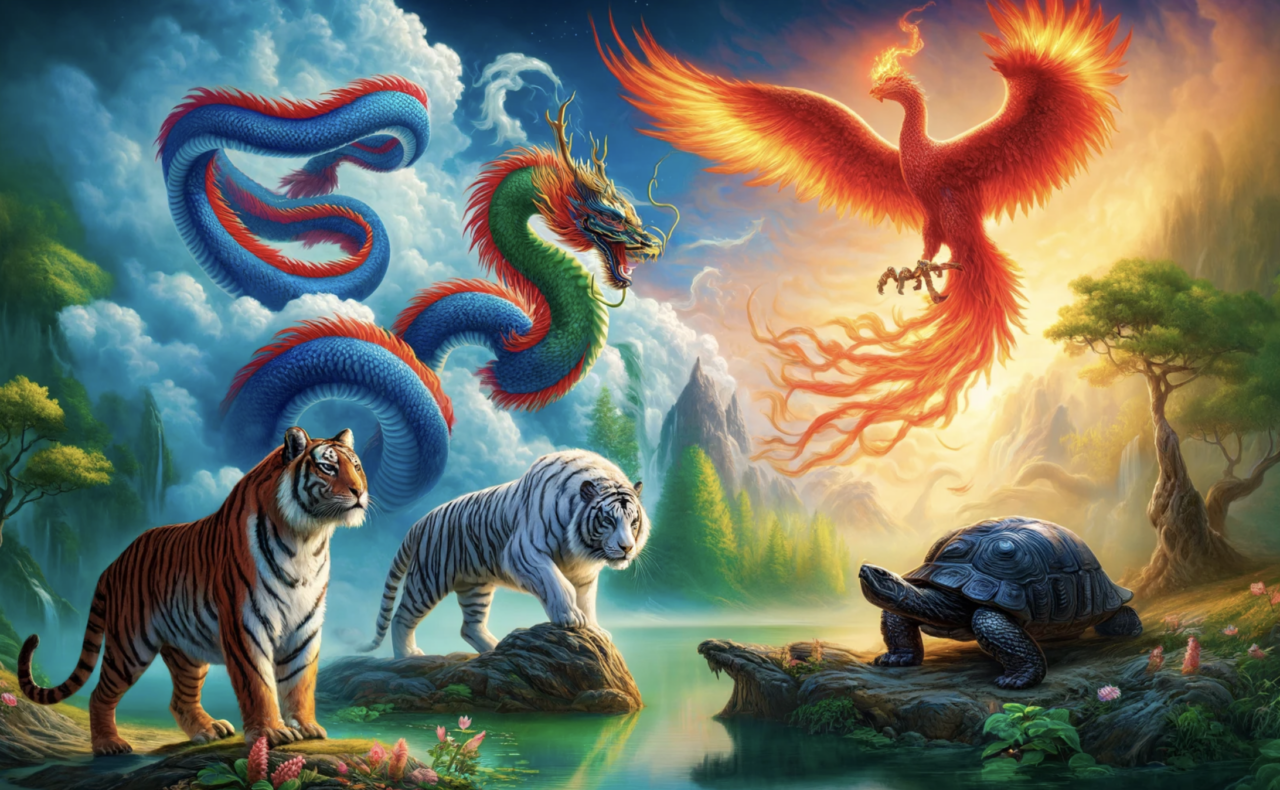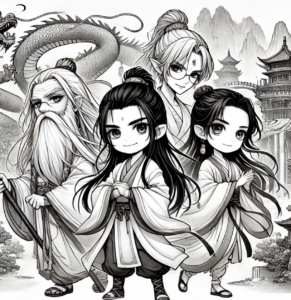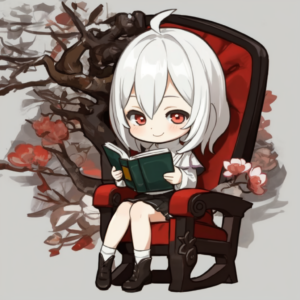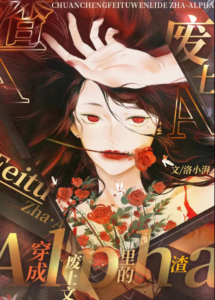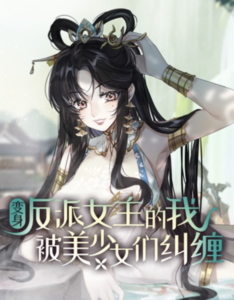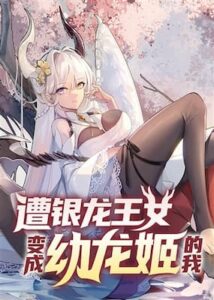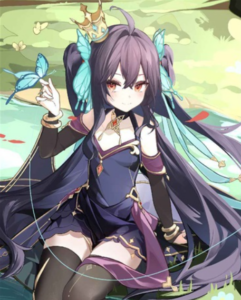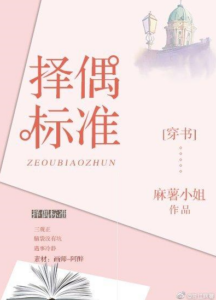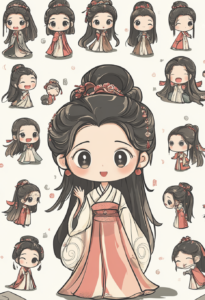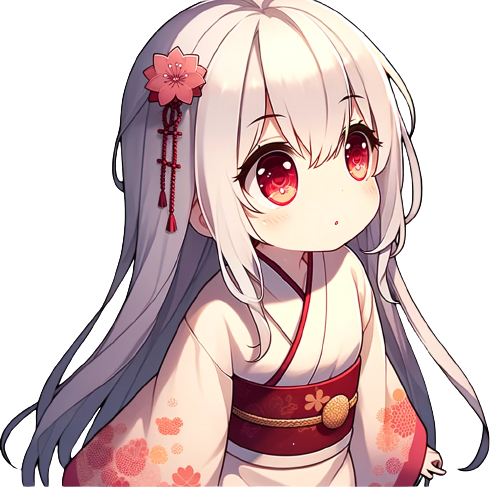The Dragon: Supreme Symbol of Power
The dragon stands as a towering figure in Chinese mythology, embodying strength, wisdom, and the sheer force of nature. It’s no wonder that this majestic creature has seeped into every facet of Chinese culture, from ancient rituals to the pages of modern light novels on platforms like LightNovels AI.
The Nine Sons of the Dragon
In the intricate world of Chinese mythology, the Dragon’s offspring are as fascinating as the supreme creature itself. Each of the Nine Sons possesses unique traits and occupies a distinct place in the area of legends. For instance, Bixi, the eldest, is known for carrying heavy loads and is often depicted beneath grave monuments. Another son, Qiu Niu, embodies the love for music, particularly favoring the strings, so becoming a symbol of inspiration for many artisans in ancient China. These sons offer a glimpse into the diverse aspects of Chinese culture, illustrating traits like strength, protection, and artistic excellence. Their stories, echoed in literature and LightNovels AI‘s enchanting light novels, such as “I Became a Villainess and Was Pestered by Beautiful Girls,” further demonstrate the dragon’s pervasive influence across Chinese lore.
The Dragon Dance: A Cultural Phenomenon
The Dragon Dance encapsulates the vibrancy and dynamism of Chinese festivities, bringing myths to life on the streets of cities and villages alike. This dance isn’t just a performance; it’s a ritual that dates back centuries, believed to bring prosperity, good luck, and scare away evil spirits. Teams of dancers skillfully manipulate long, sinuous dragons made of silk, bamboo, and paper, making the mythical creature dance to the beat of drums and cymbals. The dance peaks at Chinese New Year celebrations, but it’s also a staple at festivals, parades, and significant events, offering a spectacular display of cultural heritage and communal spirit. Its enduring popularity underscores the dragon’s role as a symbol of power, good fortune, and the unity of community, resonating well beyond the scope of ancient myths into the very heart of contemporary Chinese life.
The Phoenix: Emblem of Grace and Virtue
Following the dragon, the Phoenix, or Fenghuang in Chinese mythology, stands as another iconic emblem, representing grace and virtue. Its presence in literature and culture showcases the rich world of Chinese folklore, elegantly woven into stories that continue to fascinate audiences today.
The Fenghuang and Its Imperial Significance
The Fenghuang, unlike any ordinary bird, symbolizes high virtue and grace. Traditionally, it’s seen as the queen of all birds, embodying the union of yin and yang. This mythical creature signifies not just harmony but also imperial authority and excellence. Historical texts and legends often depict the Fenghuang as flying over auspicious locations, marking them as blessed by its divine presence. In the area of digital storytelling, platforms like LightNovelsAI highlight these creatures in their series, “I Became a Villainess and Was Pestered by Beautiful Girls” and “Senior Sister Is On Top”, intertwining traditional myths with contemporary narratives that capture the imperial elegance and profound symbolism of the Fenghuang.
Symbolism in Marriage and Femininity
Beyond imperial imagery, the Phoenix carries deep symbolism in the contexts of marriage and femininity. It is frequently paired with the dragon – the male yang counterpart – to symbolize marital bliss and perfect balance between partners. This pairing reflects the ideal of conjugal fidelity and harmony, where the Phoenix represents the ultimate virtue of a loyal, gracious, and supportive wife. In Chinese weddings, motifs of the Phoenix can often be found adorning various items, emphasizing the hope for a prosperous and balanced marriage. Similarly, in stories featured on LightNovelsAI, such as “I Am So Kind GL” and “After Flirting with the Male Lead’s Harem, I Messed Up”, the nuanced portrayal of female characters embodying grace, strength, and virtue mirrors the Fenghuang’s symbolism, bridging ancient ideals with modern-day narratives of femininity and partnership. Through these tales, the legendary Phoenix continues to inspire and influence, embodying ideals that are both timeless and evolving.
The Qilin: Bringer of Prosperity and Peace
Stepping into the world of Chinese mythology introduces us to the Qilin, a magnificent creature believed to bring prosperity and peace wherever it roams. This fabled entity stands as a testament to the rich world of Chinese folklore, embodying both the grace of a deer and the strength of a dragon.
Mythological Origins and Descriptions
The Qilin, often depicted with flames enveloping its body, is a creature of good omens, said to appear with the imminent arrival or passing of a sage or illustrious ruler. It’s a hybrid beast, with a deer’s body, a dragon’s head, and hooves that tread so gently they leave no mark upon the earth. Its presence is synonymous with the arrival of peace and prosperity, heralding a period of flourishing arts and literature. Traditionally, the Qilin is a gentle soul, refusing to harm a single blade of grass, embodying purity, and majestic grace.
Qilin in Modern Chinese Culture
In the contemporary era, the Qilin’s symbolism transcends ancient mythology, embedding itself within modern Chinese culture and digital narratives. Platforms like LightNovelsAI weave the essence of the Qilin into stories such as “I Became a Villainess and Was Pestered by Beautiful Girls” and “Senior Sister is On Top,” integrating mythological elements with modern-day scenarios. The Qilin’s attributes of prosperity, peace, and benevolence are creatively reimagined, connecting timeless ideals with the interests of today’s audience.
Through such platforms, the Qilin continues to inspire, embodying the harmonious blend of the old and new, and ensuring its place not just in mythology, but in the hearts of contemporary enthusiasts. By highlighting the creature’s involvement in stories and its integration into digital culture, the Qilin’s enduring legacy as a bringer of prosperity and peace is celebrated and perpetuated.
The White Tiger: Guardian of the West
Moving from the peaceful and prosperous Qilin, we venture into the domain of the White Tiger, a symbol of power and protection in Chinese mythology. This majestic creature stands as the guardian of the West, embodying courage and strength.
The Four Mythical Beasts and Their Directions
The White Tiger, known as Bai Hu in Chinese, is one of the Four Mythical Beasts, each guarding a cardinal direction. Alongside the Azure Dragon of the East, the Vermilion Bird of the South, and the Black Tortoise of the North, the White Tiger oversees the West. These guardians play a crucial role in Chinese cosmology, representing not just physical locations but also elements and seasons. They collectively maintain balance in the universe, with the White Tiger bringing strength and protection against evil forces.
The White Tiger in Astrology and Feng Shui
In the realms of Chinese astrology and Feng Shui, the White Tiger holds significant influence. It symbolizes the western direction and is associated with the fall season, embodying the metal element in the Wu Xing system. Its presence in a person’s astrological chart indicates a powerful protector, offering courage and valiant assistance during challenging times.
Feng Shui, the ancient art of placement and energy flow, regards the White Tiger as a symbol of stability and protection for a home or office. Including imagery or statues of the White Tiger in the western part of a space is believed to ward off negative energy, ensuring a harmonious environment.
Transitioning from the symbolic peace of the Qilin, the White Tiger introduces a blend of might and guardianship into modern storytelling platforms like LightNovelsAI. Through tales on websites such as “I Became a Villainess and Was Pestered by Beautiful Girls” and “Senior Sister is On Top,” the White Tiger’s attributes are woven into narratives, showcasing its enduring appeal in both traditional and contemporary contexts. As readers explore these tales, they’re not just entertained, but also connected with the rich world of Chinese mythology, where ancient creatures guide, protect, and inspire.
The Black Tortoise: Protector of the North
Following the White Tiger, the Black Tortoise is another revered figure in Chinese mythology, serving as the guardian of the North. It’s a symbol of longevity, stability, and protection against evil forces, playing a pivotal role in celestial symbolism and the balance of energies. In modern renditions, such as those found on LightNovels AI, the Black Tortoise’s characteristics are woven into narratives, enriching stories with layers of mythological depth.
Symbolism of Longevity and Stability
The Black Tortoise, known as Xuanwu in Chinese, is often depicted along with a snake, symbolizing the unity of yin and yang. It represents the winter season and water element, embodying longevity, wisdom, and stability. This creature’s association with longevity isn’t just about a long life but also the endurance and resilience required to overcome challenges. In digital storytelling platforms like LightNovels AI, the Tortoise’s symbolism is revisited, providing characters and plots with a grounding in endurance and the wisdom of age, appealing to readers’ fascination with ancient wisdom applied in contemporary dilemmas.
The Tortoise in Astrological Traditions
Astrologically, the Black Tortoise holds a significant place among the four celestial animals, each guarding a direction and influencing astrological energies. It’s associated with the North and the cold winter months, influencing those born under its watch with characteristics of resilience, strategic thinking, and reliability. The creature’s astrological significance transcends mere symbolism; it’s employed in Feng Shui and Chinese astrology to promote harmony, attract positive energy, and ward off negative influences. Stories on LightNovels AI tap into these astrological beliefs, embedding Chinese astrological concepts into character development and plot mechanisms, allowing a richer narrative experience that honors the complexity of Chinese mythological and astrological traditions.
Lesser-Known Creatures of Chinese Mythology
Delving deeper into the rich world of Chinese mythology brings us to a area of lesser-known, yet equally fascinating creatures. These beings not only add complexity to mythical narratives but also offer intriguing insights into ancient Chinese beliefs and values.
The Nine-Tailed Fox
The Nine-Tailed Fox, or Huli Jing, embodies a duality that has captivated storytellers for centuries. Initially feared as cunning seductresses, these fox spirits evolved in folklore to become symbols of love and protection. Their stories, rich with themes of transformation and redemption, have found new life in modern narratives on platforms like LightNovels AI, where they navigate complex relationships and moral dilemmas, reflecting the multifaceted nature of humanity.
The Jiangshi
The Jiangshi, China’s hopping vampire, merges horror with humor. These reanimated corpses, stiff from rigor mortis, move by hopping and drain life essence from the living. Portrayed with a blend of fear and comedy, Jiangshi stories serve as cautionary tales about the dangers of disturbing the dead. This fascinating blend of horror and humor has leaped into popular culture, inspiring characters that navigate the line between the grotesque and the absurd in stories featured on LightNovels AI.
The Pixiu
Pixiu, celestial creatures resembling lions with wings, are revered as powerful protectors that ward off evil spirits and attract wealth. Traditionally placed in homes and businesses, Pixiu symbolize the pursuit of prosperity and security. Their mythological significance has seamlessly transitioned into the digital age, with Pixiu characters playing roles in narratives that explore themes of protection, fortune, and spiritual growth on platforms like LightNovels AI.
The Taotie
The Taotie remains one of the most mysterious figures in Chinese mythology, often depicted on ancient bronze vessels and known for its voracious appetite. Believed to represent gluttony and greed, the Taotie challenges characters in modern myths to confront and overcome their deepest desires and fears, adding a layer of psychological depth to tales that resonate with timeless human struggles.
The Luan
Luan, a mythical bird said to rival the phoenix in beauty and grandeur, symbolizes great prosperity and harmony. Appearing in legends that depict it as a herald of peace, the Luan inspires narratives of reconciliation and unity. In digital storytelling, Luan characters often begin on quests that underscore the importance of cooperation and understanding, embodying ideals that transcend the boundaries of myth.
The Bi Xi
Bi Xi, one of the nine sons of the dragon, resembles a tortoise entwined with a serpent and is celebrated for its strength and endurance. Known to carry heavy burdens and support monumental structures, Bi Xi exemplify perseverance and resilience. Their stories, woven into the fabric of digital literature on platforms like LightNovels AI, serve as reminders that even the mightiest challenges can be overcome with patience and determination.
Each of these lesser-known creatures adds a unique flavor to the rich stew of Chinese mythology, offering endless possibilities for storytelling that bridges the ancient with the contemporary, reflecting the timeless appeal of mythological exploration.
Explore mythological creatures inside novels on Lightnovels AI
Chinese mythology reveals a world rich with intricate beings, each embodying the ancient wisdom and cultural values that have shaped narratives for centuries. From the transformative Nine-Tailed Fox to the wealth-bringing Pixiu, these creatures not only add depth to stories but also offer a glimpse into the complexities of human nature and societal ideals. As they evolve from traditional myths to dynamic characters in modern digital storytelling, they continue to inspire and captivate audiences around the world. LightNovels AI stands at the forefront of this cultural preservation, offering a platform where these ancient myths breathe new life into contemporary tales. It’s a testament to the enduring power of storytelling and its ability to bridge the past with the present.
Frequently Asked Questions
What is the significance of the Nine-Tailed Fox in Chinese mythology?
The Nine-Tailed Fox in Chinese mythology symbolizes transformation and redemption. Initially seen as a seductress, its image has evolved into a protective figure in modern narratives, representing complex character development.
Who or what is Jiangshi in Chinese cultural tales?
Jiangshi is known as the hopping vampire in Chinese folklore. It combines elements of horror and humor in cautionary tales, serving as a unique reflection of cultural beliefs and superstitions about the undead.
How does Pixiu reflect ancient Chinese beliefs in modern storytelling?
Pixiu, a celestial protector of wealth and prosperity, reflects ancient Chinese beliefs in modern storytelling by transitioning into digital narratives. It symbolizes the seamless blending of traditional symbols with contemporary themes, especially in stories about wealth acquisition and protection.
What role does the Taotie play in narratives?
The Taotie presents challenges for characters to confront their deepest desires and fears, adding a layer of psychological depth to narratives. It embodies the concept of gluttony and the consequences of excess in mythological stories.
What does the Luan represent in Chinese mythology?
Luan symbolizes prosperity, unity, and peace in Chinese mythology. Its presence in stories often inspires narratives centered around cooperation and the collective pursuit of shared goals, reflecting ancient desires for harmony and success.
How does Bi Xi contribute to themes of perseverance in storytelling?
Bi Xi, known for its strength and endurance, exemplifies perseverance in overcoming challenges within stories. This creature is often depicted as a steadfast figure that inspires characters to persist through difficulties, mirroring the human journey of resilience.

